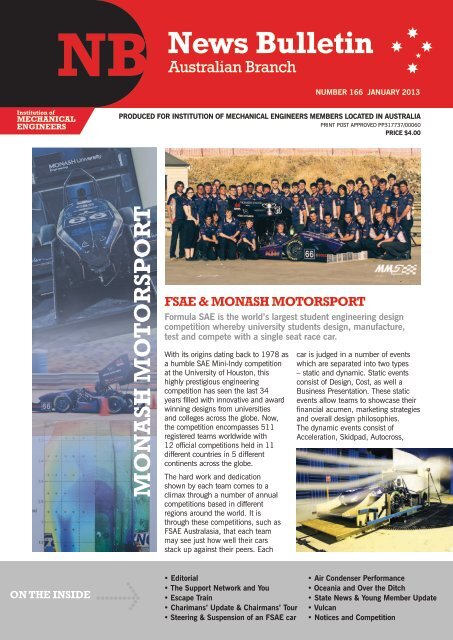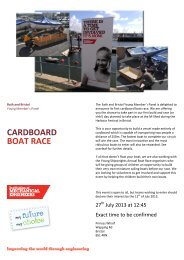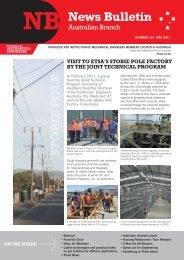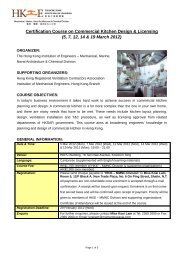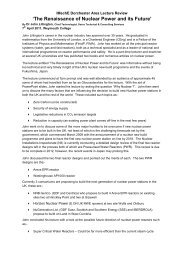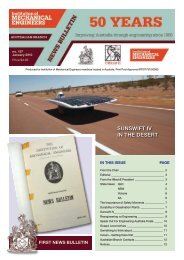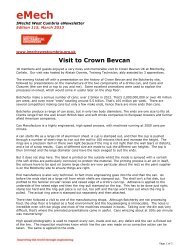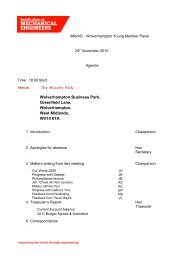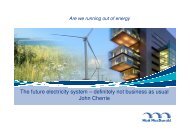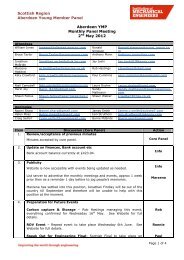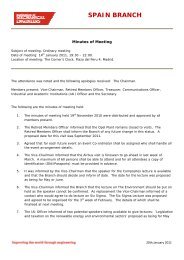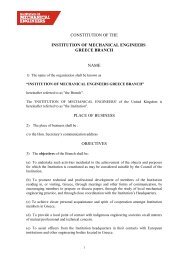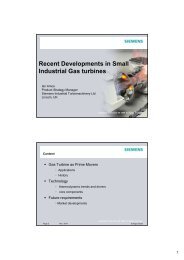Download - Near You - Institution of Mechanical Engineers
Download - Near You - Institution of Mechanical Engineers
Download - Near You - Institution of Mechanical Engineers
Create successful ePaper yourself
Turn your PDF publications into a flip-book with our unique Google optimized e-Paper software.
oN thE iNSidE<br />
NB<br />
News Bulletin<br />
Australian Branch<br />
nuMber 166 january 2013<br />
Produced for InstItutIon <strong>of</strong> MechanIcal engIneers MeMbers located In australIa<br />
Print Post APProved PP317737/00060<br />
PrIce $4.00<br />
MoNASh MotorSport<br />
FSAE & MoNASh MotorSport<br />
formula sae is the world’s largest student engineering design<br />
competition whereby university students design, manufacture,<br />
test and compete with a single seat race car.<br />
With its origins dating back to 1978 as<br />
a humble SAE Mini-Indy competition<br />
at the University <strong>of</strong> Houston, this<br />
highly prestigious engineering<br />
competition has seen the last 34<br />
years filled with innovative and award<br />
winning designs from universities<br />
and colleges across the globe. Now,<br />
the competition encompasses 511<br />
registered teams worldwide with<br />
12 <strong>of</strong>ficial competitions held in 11<br />
different countries in 5 different<br />
continents across the globe.<br />
The hard work and dedication<br />
shown by each team comes to a<br />
climax through a number <strong>of</strong> annual<br />
competitions based in different<br />
regions around the world. It is<br />
through these competitions, such as<br />
FSAE Australasia, that each team<br />
may see just how well their cars<br />
stack up against their peers. Each<br />
• editorial<br />
• the support network and you<br />
• escape train<br />
• charimans’ update & chairmans’ tour<br />
• steering & suspension <strong>of</strong> an fsae car<br />
car is judged in a number <strong>of</strong> events<br />
which are separated into two types<br />
– static and dynamic. Static events<br />
consist <strong>of</strong> Design, Cost, as well a<br />
Business Presentation. These static<br />
events allow teams to showcase their<br />
financial acumen, marketing strategies<br />
and overall design philosophies.<br />
The dynamic events consist <strong>of</strong><br />
Acceleration, Skidpad, Autocross,<br />
• air condenser Performance<br />
• oceania and over the ditch<br />
• state news & young Member update<br />
• Vulcan<br />
• notices and competition
2<br />
Fuel Economy and Endurance. In<br />
these events, teams may directly<br />
compare their designs on track, where<br />
each team has the opportunity to<br />
demonstrate the capabilities <strong>of</strong> their<br />
vehicles.<br />
Monash Motorsport is one such<br />
team from Monash university,<br />
Melbourne<br />
The team started with humble<br />
beginnings in 2000, where the current<br />
Academic Advisor, Dr Scott Wordley,<br />
helped organise the first Australasian<br />
competition. With approximately 25<br />
senior members, and 25 recruits<br />
every year, the team comprises <strong>of</strong><br />
business, industrial design, science<br />
and engineering students across a<br />
multitude <strong>of</strong> majors and disciplines.<br />
The team is structured starting with<br />
top level management comprising <strong>of</strong><br />
senior members, leading onto four<br />
technical sections: Aerodynamics,<br />
Chassis/Driver Controls, Suspension<br />
and Powertrain. Technical leads are<br />
responsible for each section, though<br />
the Chief Engineer is responsible for<br />
the bigger picture integration <strong>of</strong> each<br />
section. That said, the project is more<br />
than the technical aspect it may first<br />
seem; the business team is a vital<br />
part <strong>of</strong> the team, responsible for the<br />
team’s finances, sponsorship, public<br />
relations and marketing. At the end<br />
<strong>of</strong> the day, it’s all one big demanding<br />
exercise in teamwork, leadership and<br />
project management.<br />
Monash Motorsports last<br />
year – local & international<br />
competition highlights<br />
The last 12 months has seen an<br />
incredibly busy and exciting period<br />
for Monash Motorsport. In December<br />
2011 the team was placed ahead <strong>of</strong><br />
news bulletin – no.166 January 2013<br />
24 other universities from the Asia-<br />
Pacific region and were declared<br />
FSAE-Australasia Champions for the<br />
third year running. From here, the<br />
team set its sights for Europe in 2012<br />
with the first four months <strong>of</strong> 2012<br />
allocated to further developing M11<br />
(the 2011 car) reaching a refined and<br />
improved version to be shipped to<br />
Germany in April 2012. These months<br />
<strong>of</strong> manufacture, driver training, testing,<br />
as well as design work for M12, were<br />
to culminate in the highlight <strong>of</strong> the<br />
year, Formula Student UK (organised<br />
by IMechE) and Formula Student<br />
Germany, held at the Silverstone<br />
Circuit and the Hockenheimring<br />
respectively.<br />
FSUK saw Monash Motorsport placed<br />
third overall, taking first place in static<br />
events, and receiving the Jaguar<br />
Simulation Award. FSG resulted in<br />
Monash being placed fourth overall<br />
and third in the Design event.<br />
Consistency over the past few years<br />
on top <strong>of</strong> Monash’s achievements in<br />
Europe has resulted in a current world<br />
ranking <strong>of</strong> second.<br />
What the future holds –<br />
events, developments<br />
Throughout the European campaign,<br />
some <strong>of</strong> the team remained in<br />
Melbourne to continue with the<br />
manufacture <strong>of</strong> M12. Once the entire<br />
team was back in Melbourne, the<br />
team was in the full swing <strong>of</strong> M12<br />
manufacture in preparation for FSAE<br />
Australasia 2012 in December.<br />
Next year will incorporate many<br />
exciting design changes for M13<br />
as the team will hit the drawing<br />
boards and computer labs at Monash<br />
University throughout the summer.<br />
One <strong>of</strong> the aspects Monash Motorsport<br />
prides itself on is its continual<br />
commitment to vehicle aerodynamics<br />
research and development. The<br />
conceptual design phase leads into<br />
Computational Fluid Dynamics<br />
(CFD) simulations using the National<br />
Computational Infrastructure<br />
(Australia’s largest supercomputer<br />
situated in Canberra) for simulations<br />
<strong>of</strong> 40 million meshing elements. From<br />
here, designs are manufactured and<br />
taken into the Monash Wind Tunnel<br />
for full scale wind tunnel testing, with<br />
further validation and analysis being<br />
conducted on track using techniques<br />
such as pressure tapping the undertray;<br />
thus gaining a better understanding <strong>of</strong><br />
the airflow in ground effect.<br />
Recent developments include a Drag<br />
Reduction System (DRS) for the front<br />
and rear wing whereby servos actuate<br />
the flaps from high downforce to low<br />
drag positions, as well as further CFD<br />
analysis with research into rotating<br />
reference frames to more accurately<br />
represent airflow whilst cornering (with<br />
meshes <strong>of</strong> 100+ million elements).<br />
These studies, paired with rotating<br />
wheels, radiator porosity modeling and<br />
complex geometry, make for some very<br />
intricate, though interesting, problems!<br />
Why young engineers should<br />
get involved<br />
<strong>You</strong>ng engineers should get involved<br />
in this extremely rewarding and<br />
prestigious competition as it is one <strong>of</strong><br />
the few real industry experiences and<br />
exposures available to engineering<br />
students within university life. Not<br />
only do the practical skills developed<br />
strongly complement the more<br />
theoretical aspects taught in lectures<br />
and textbooks, but team members<br />
enrich their education with further<br />
leadership, communication and project<br />
management experience. These are<br />
vital skills in industry which so many<br />
employers seek, especially from recent<br />
engineering graduates. Apart from the<br />
obvious career benefits with the skills<br />
that are nurtured, the competition<br />
allows participants to create strong<br />
friendships for life from around the<br />
world, not to mention advantageous<br />
networking.<br />
australian universities with teams<br />
at fsae-australasia 2012<br />
Univeristy <strong>of</strong> Western Australia<br />
University <strong>of</strong> Newcastle<br />
Edith Cowan University<br />
University <strong>of</strong> Adelaide<br />
University <strong>of</strong> Wollongong<br />
RMIT University<br />
Curtin University<br />
University <strong>of</strong> South Australia<br />
Swinburne University <strong>of</strong> Technology<br />
University <strong>of</strong> Sydney<br />
University <strong>of</strong> Queensland<br />
Queensland University <strong>of</strong> Technology<br />
University <strong>of</strong> Technology Sydney<br />
University <strong>of</strong> New South Wales<br />
Monash University<br />
University <strong>of</strong> Melbourne
EditoriAl<br />
This edition is dedicated to the <strong>You</strong>ng<br />
Members <strong>of</strong> the Australian Branch.<br />
All the volunteers within the Oceania<br />
Region work hard to provide technical<br />
lectures, social events and value<br />
for your membership fee. However,<br />
recently there has been a particularly<br />
large wave <strong>of</strong> young volunteers acting<br />
above and beyond what is expected<br />
<strong>of</strong> them. In NSW the new committee<br />
is dominated by <strong>You</strong>ng Members,<br />
Queensland will be hosting a <strong>You</strong>ng<br />
Members “Engtravaganza” and Belinda<br />
and I have flown the flag for Australia<br />
by each winning, IMechE <strong>You</strong>ng<br />
Member <strong>of</strong> the Year Awards.<br />
The Australian <strong>You</strong>ng Members section<br />
is also paving the way in social media<br />
with a distinct presence on Facebook<br />
and Twitter.<br />
I hope you enjoy this issue and I look<br />
forward to comments, feedback and<br />
any articles you would like to see<br />
published.<br />
Matthew springer<br />
australiaweb2@imechenetwork.org<br />
check out the nearyou pages on<br />
imeche.org for contact details and<br />
events.<br />
thE Support<br />
NEtwork<br />
ANd <strong>You</strong><br />
support network is a charity<br />
for IMeche members and their<br />
family. We provide advice,<br />
practical support and finance<br />
to help with day-to-day<br />
problems and the unexpected<br />
circumstances that life brings<br />
along the way.<br />
We are co-located with the <strong>Institution</strong><br />
at Birdcage Walk in London, but<br />
operate on an international basis –<br />
as our services follow the member,<br />
wherever they are in the world.<br />
All Support Network Trustees are<br />
IMechE members, as are all <strong>of</strong> our<br />
volunteers. We are grateful for the<br />
annual donations that members make<br />
to the fund and we very much feel<br />
that we are part <strong>of</strong> the wider IMechE<br />
community.<br />
Until recently however, the fund<br />
largely supported the widows <strong>of</strong> former<br />
members and did not adequately<br />
address other needs. Things have<br />
changed, and whilst we still assist<br />
widows and older people, (and will<br />
always do so), our priority focus<br />
now is much more on the needs <strong>of</strong><br />
undergraduates and/or members <strong>of</strong> a<br />
working age, as they form the majority<br />
group <strong>of</strong> IMechE membership.<br />
Additionally, we are simultaneously<br />
trying to increase our international<br />
reach, as we want to ensure that we<br />
are in a position to help all members<br />
and, whilst 20% <strong>of</strong> IMechE members<br />
reside outside <strong>of</strong> the UK, this is not<br />
currently represented in our current<br />
enquiry and/or assisted pr<strong>of</strong>ile.<br />
We very much welcome feedback from<br />
international members to help us with<br />
shaping our service <strong>of</strong>ferings, so even<br />
if you do not need our help, we would<br />
love to hear from you.<br />
Our current services include:<br />
eMPloyMent coachIng:<br />
We can help to give you a head start<br />
and/or refresher with job seeking skills<br />
including CV preparation, making<br />
applications and interview technique.<br />
We have a permanent partner agency<br />
in Australia and New Zealand, and we<br />
would endeavour to find equivalent<br />
partners in Papua New Guinea and<br />
other areas as required. We can<br />
provide a single session and/or a<br />
longer, more intensive programme,<br />
depending on your situation.<br />
fInancIal suPPort: Shortterm<br />
‘breathing space’ payments can<br />
be provided during times <strong>of</strong> need to<br />
help you keep on top <strong>of</strong> things. We<br />
use volunteers near to you to ensure<br />
that currency and/or cost <strong>of</strong> living<br />
issues are appropriate, and we use<br />
online banking to transfer funds direct<br />
to your bank account. If you are<br />
regularly finding it hard to make ends<br />
meet, and are getting behind, we can<br />
Members supported 2010 – 2012<br />
also help with debt advice – to reduce<br />
and/or avoid indebtedness.<br />
faMIly suPPort: We can try<br />
and ease the costs and/or demands<br />
<strong>of</strong> specific situations which might<br />
otherwise stretch your pocket or<br />
your emotions. For example through<br />
providing new baby grants, access<br />
to specialist support such as autism,<br />
dyslexia, caring for elders and/<br />
or meeting the needs <strong>of</strong> disabled<br />
children.<br />
undergraduates: We<br />
provide grants to members on IMechE<br />
accredited degrees. We also help<br />
student members on other mechanical<br />
engineering first degrees and/or higher<br />
level related courses, depending on<br />
their financial circumstances.<br />
All <strong>of</strong> our services are free for you<br />
and your family to use as a benefit <strong>of</strong><br />
your membership <strong>of</strong> the <strong>Institution</strong>.<br />
Members, partners and dependants<br />
are all eligible to contact the Support<br />
Network directly.<br />
Further details can be found from our<br />
website at www.supportnetwork.org.uk<br />
or via the About Us link on the IMechE<br />
homepage, but please do get in touch<br />
with us if you think we might be able<br />
to help; as we only help members and<br />
their family, we try and be as flexible as<br />
possible – which might include doing<br />
something we have not done before, so<br />
it’s best to ask! If we cannot provide a<br />
solution ourselves, we will endeavour<br />
to work with others who can. We<br />
would therefore encourage all members<br />
and dependants to think <strong>of</strong> us as a<br />
‘first point <strong>of</strong> contact’ to help ease you<br />
through these difficult times.<br />
anni broadhead, ceo<br />
a_broadhead@supportnetwork.org.uk<br />
service 2010 2011 2012 (at end oct)<br />
Employment coaching 14 25 49<br />
Financial support 154 148 139<br />
Debt advice 196 224 240 (at end Sept)<br />
Undergraduates 11 21 28<br />
news bulletin – no.166 JAnUARY 2013 3
4<br />
EScApE trAiN<br />
amy lezala <strong>of</strong> bombardier<br />
transportation, delivered a<br />
presentation on evacuation<br />
time modelling within the<br />
railway industry as part <strong>of</strong><br />
the Victorian speak out<br />
for engineering (s<strong>of</strong>e)<br />
competition. below is a<br />
summary for News Bulletin.<br />
Evacuation time is an important<br />
measure <strong>of</strong> a railway vehicle design for<br />
both station dwell time optimisation<br />
as well as passenger survival in the<br />
event <strong>of</strong> a fire. A design is deemed<br />
safe for life safety if the Available Safe<br />
Evacuation Time [ASET] is greater<br />
than the Required Safe Evacuation<br />
Time [RSET].<br />
The assessment <strong>of</strong> railway vehicle<br />
evacuation is based on general fire<br />
engineering principles. The current<br />
methods are practical live trials or<br />
theoretical engineering assessments.<br />
Live trials are costly and impractical as<br />
they require a full vehicle to conduct<br />
the assessment. The trial cannot be<br />
conducted prior to manufacture but<br />
the results give a true assessment<br />
<strong>of</strong> the specific design. Engineering<br />
assessments are cost effective and can<br />
be conducted prior to manufacturing,<br />
allowing for design improvements<br />
to be identified at an early stage.<br />
This method, however, is based on<br />
assumptions and theory. An alternative<br />
method is required to minimise the<br />
number <strong>of</strong> assumptions and to address<br />
the railways industry’s move towards a<br />
reduction in product delivery time.<br />
Advancement in technology provides<br />
the opportunity to use Computational<br />
Fluid Dynamics [CFD] for determining<br />
railway vehicle evacuation time.<br />
This method is less expensive than<br />
live trials and assesses the specific<br />
design. CFD programmes have the<br />
ability to assess computer models<br />
<strong>of</strong> the design, allowing for design<br />
improvements to be identified prior<br />
to manufacture. Validation <strong>of</strong> this<br />
method is required as the CFD<br />
technology available introduces<br />
assumptions for ease <strong>of</strong> modelling.<br />
The research project presented at the<br />
Victoria heat <strong>of</strong> the IMechE SOfE 2012<br />
news bulletin – no.166 January 2013<br />
competition aimed to establish which<br />
<strong>of</strong> the three methods is recommended<br />
for use in the railway industry going<br />
forward. This has been achieved<br />
by assessing a generic Bombardier<br />
Transportation rail vehicle using each<br />
<strong>of</strong> the three methods. The results <strong>of</strong><br />
the assessments have been compared<br />
to typical contractual and legal<br />
requirements <strong>of</strong> the design to verify the<br />
methods. The three methods have also<br />
been compared to each other based on<br />
the validity <strong>of</strong> results and process.<br />
The results show that a live trial,<br />
an engineering assessment and a<br />
CFD simulation deliver a similar<br />
evacuation time; however the CFD<br />
assumptions are not reflective <strong>of</strong> the<br />
in-service performance. Live trials and<br />
engineering assessments are therefore<br />
reliable methods for determining<br />
evacuation time <strong>of</strong> railway vehicles<br />
whereas CFD is currently only suitable<br />
for supporting the other methods.<br />
Although it is reliable, a live trial<br />
assessment is not practical for use<br />
in the railway industry. Engineering<br />
assessments are therefore the most<br />
ideal method, particularly when<br />
supported with CFD simulations.<br />
Engineering assessments are<br />
theoretical and are currently based<br />
on dated live trials. To improve the<br />
validity <strong>of</strong> this method the railway<br />
industry needs to develop a database<br />
<strong>of</strong> evacuation times to support these<br />
assessments, either through a research<br />
project or through knowledge sharing.<br />
The open-source CFD s<strong>of</strong>tware used<br />
in throughout the research project<br />
assessed the impact <strong>of</strong> the fire on<br />
occupant behaviour but could not<br />
simulate evacuation along the narrow<br />
aisles <strong>of</strong> the railway vehicle. There is<br />
an opportunity for the development <strong>of</strong><br />
an economic CFD s<strong>of</strong>tware programme<br />
which analyses the impact <strong>of</strong> fire on<br />
evacuation and is capable <strong>of</strong> modelling<br />
to the detail <strong>of</strong> the narrow architecture<br />
seen in the transportation industries.<br />
There is great potential in applying<br />
CFD practices to evacuation<br />
assessments but the technology is<br />
not currently available. With more<br />
investment the possibility could<br />
become a reality. The use <strong>of</strong> CFD<br />
would allow for design specific<br />
evacuation assessments which<br />
provide the opportunity to identify<br />
passenger flow improvements<br />
prior to manufacture. Improving<br />
passenger flow through layout design<br />
will optimise safe evacuation in an<br />
emergency as well as reduce station<br />
dwell times. With the application<br />
<strong>of</strong> science we can deliver improved<br />
vehicle designs.<br />
amy lezala<br />
RAMS Engineer<br />
Bombardier Transportation
FroM thE chAir<br />
greetings all.<br />
Ever had one <strong>of</strong> those conversations<br />
where you understood each <strong>of</strong> the<br />
words individually, but had absolutely<br />
no idea what they meant when they<br />
were placed in a sentence together?<br />
Well that happened recently in<br />
Auckland. Whilst participating in the<br />
IMechE Regional Meeting, poor Matt<br />
Springer had the painful pleasure<br />
<strong>of</strong> trying to explain to me what the<br />
IMechE Facebook and Twitter presence<br />
was. Now, I am a self-confessed<br />
luddite, and obviously middle aged,<br />
because as Matt explained how<br />
many likes we had, and that he had<br />
re-tweeted a tweet from somewhere<br />
else, I had absolutely no idea what<br />
he meant. Oh well, thank god for<br />
Generation Y.<br />
our facebook and twitter<br />
presence is fantastic.<br />
For any <strong>of</strong> you more conversant with<br />
social media than I am, you too can<br />
like us at: http://www.facebook.com/<br />
pages/IMeche-australian-young-<br />
Members-Panel<br />
or follow the tweets at<br />
@IMeche_ozyM.<br />
The Auckland Meeting did provide<br />
an interesting insight into the level<br />
<strong>of</strong> cooperation in New Zealand<br />
thE chAirMANS tour<br />
over the past twelve months Ian Mash, the australian branch<br />
chairman, has been visiting all <strong>of</strong> the panels and delivering a<br />
presentation on risk assessment and motorsport.<br />
Making technical presentations to<br />
your peers remains a source <strong>of</strong> fear<br />
for many. Hours spent in front <strong>of</strong><br />
the bathroom mirror rehearsing and<br />
rehearsing. I have spent quite a few<br />
hours whilst mentoring coaching<br />
and guiding on some <strong>of</strong> the do’s and<br />
don’ts <strong>of</strong> making such presentations.<br />
Somehow this year, I found myself<br />
having to follow my own advice when<br />
I was encouraged (because press<br />
ganged is such a vulgar word!) into<br />
presenting my paper on Superkarting<br />
around the Panels.<br />
between our institution, and IPENZ<br />
– the <strong>Institution</strong> <strong>of</strong> Pr<strong>of</strong>essional<br />
<strong>Engineers</strong> in New Zealand. Much<br />
as we do here in Australia with<br />
IEAUst, it was informative to see<br />
joint learned society activities, and<br />
a steely determination to provide<br />
something back to the membership.<br />
Also, the challenges seemed similar<br />
across the ditch too. How to engage<br />
younger members (maybe they could<br />
try that face-tweet thing too?), and<br />
how to keep the few active volunteers<br />
from suffering burn out. This is a<br />
challenge here in Australia too, and<br />
so it is always heartening when new<br />
volunteers pop up to support the<br />
running <strong>of</strong> the branch.<br />
NSW has seen a bolstering <strong>of</strong> the local<br />
committee to a level not seen for many<br />
years. Queensland continues to set the<br />
benchmark for a vigorous and healthy<br />
panel membership too. So much so<br />
in fact, that in addition to everything<br />
else on the go, the Queensland Panel<br />
has also taken on the challenge <strong>of</strong><br />
organising the AGM for March 2013.<br />
The change <strong>of</strong> venue from Adelaide<br />
is unfortunate but necessary. Owing<br />
to the pressures <strong>of</strong> time, work and<br />
family, it has meant that the local SA<br />
panel has entered a rebuilding phase.<br />
This cycle is not uncommon, and I am<br />
certain SA will re-emerge as a healthy<br />
panel in the near future. If you happen<br />
to be SA based and wish to assist, I’d<br />
be happy to hear from you.<br />
The paper focuses on the subject <strong>of</strong><br />
risk assessment, and the application<br />
<strong>of</strong> this <strong>of</strong>ten inadequately completed<br />
process to a very entertaining subject,<br />
that <strong>of</strong> racing Superkarts around Mt<br />
Panorama at Bathurst. These little<br />
race machines are incredible in terms<br />
<strong>of</strong> their performance and handling.<br />
The paper recounts the application <strong>of</strong><br />
the risk assessment process in a bid<br />
to change the track license to allow<br />
Superkarts to join Formula Vee and<br />
Formula 3 as open wheel race cars<br />
permitted to run around the Bathurst<br />
race track.<br />
The volunteer base is also busy<br />
conducting an unprecedented number<br />
<strong>of</strong> pr<strong>of</strong>essional interviews. I cannot<br />
recall a busier period – and believe<br />
metrics <strong>of</strong> interviews conducted in<br />
Australia in that last 12 months<br />
exceeds everywhere except London.<br />
I have heard it said that some<br />
incorrectly believe you cannot become<br />
chartered, or achieve fellowship,<br />
through the IMechE here in Australia.<br />
Wrong – wrong – wrong. The same<br />
process applies as if you were in<br />
London, the same forms are completed<br />
and sent to HQ, only the interview will<br />
require a little travel (especially if you<br />
live in Cairns!). I hope the current bow<br />
wave <strong>of</strong> applications continues.<br />
As I type this the festive season is<br />
approaching fast. However, by the<br />
time you read this, those festivities<br />
will be a fading image in the rear<br />
view mirror. I therefore hope you had<br />
a pleasant festive break, and hope to<br />
see as many <strong>of</strong> you as possible for the<br />
AGM in Brisbane.<br />
Anyway, <strong>of</strong>f now to enjoy that fact<br />
that whilst I failed to comprehend or<br />
embrace either twitter or Facebook,<br />
I did find the word ‘fart’ in the word<br />
search last issue. Come on, admit it. I<br />
cannot be the only one who chuckled<br />
(am I?). Who said that expensive<br />
engineering education was lost on me!<br />
Cheers all.<br />
Ian Mash<br />
news bulletin – no.166 JAnUARY 2013 00 5
6<br />
Motorsport is considered by some,<br />
and somewhat emotionally, to be<br />
a dangerous activity. However, that<br />
speaks to the issue; what is safety?<br />
Safety is a relative concept, therefore<br />
any engineer should be considering<br />
‘how safe is safe enough?’ Whether<br />
the term ALARP or SFAIRP (see box<br />
inset) is used (and they are different),<br />
clarity <strong>of</strong> thought can be achieved by<br />
considering what and who defines risk<br />
tolerability and risk acceptability in<br />
any situation.<br />
In the example chosen, the risk<br />
assessment has so far been<br />
unsuccessful in achieving the change<br />
to the track license. The paper<br />
was intended to demystify the risk<br />
assessment process, and show how a<br />
good risk assessment should affect the<br />
decision making process, where the<br />
emotion and politics do not dominate.<br />
Starting in NSW, the paper was well<br />
news bulletin – no.166 January 2013<br />
received by an audience <strong>of</strong> 70 or so.<br />
The questions and answer session<br />
proved most enjoyable, with a mix <strong>of</strong><br />
questions from engineers and other<br />
race drivers alike. Then on a business<br />
trip to WA, the opportunity presented<br />
itself to make the presentation to the<br />
WA Panel. Again audience numbers<br />
were excellent, with around 50 in<br />
attendance. What struck me in WA was<br />
how vibrant the Panel was, and how<br />
well IEAust and IMechE are cooperating<br />
to bring together a robust service<br />
<strong>of</strong>fering to their respective members.<br />
Audience numbers were regrettably<br />
much lower when I presented<br />
the paper in South Australia, but<br />
those who attended seemed to take<br />
something from the presentation.<br />
The lower numbers did allow a much<br />
deeper level <strong>of</strong> questioning – which<br />
was fun.<br />
In late August I was invited to attend<br />
alarP – as low as reasonably Possible<br />
sfaIrP – so far as Is reasonably Practicable<br />
the Queensland Annual Dinner, and<br />
gave an abridged version <strong>of</strong> my paper<br />
after a lovely 2 course meal. Audience<br />
numbers were about 30, and in this<br />
case, I did feel a little pressure as the<br />
audience had paid to be there!<br />
Most recently, I enjoyed the opportunity<br />
to present in Victoria. It is always a<br />
refreshing problem to see committee<br />
members scurrying round bringing<br />
more and more chairs into the<br />
auditorium. What a lovely problem<br />
for any panel to have! I believe the<br />
audience numbered 60 or so in the<br />
end, but irrespective, the room was full.<br />
Through this tour the Australian<br />
Branch achieved another <strong>of</strong> our<br />
objectives: to make the Chairman<br />
accessible to the Panels and their<br />
members. I was fortunate enough<br />
to share conversations with a great<br />
many <strong>of</strong> our members around this<br />
vast country, and share my passion<br />
for engineering and motorsport with<br />
around 250 fellow engineers. That<br />
alone, made the few nights away from<br />
the family almost tolerable.<br />
Ian Mash<br />
editor’s note – Ian also presented his<br />
paper at New Zealand’s <strong>Mechanical</strong><br />
Engineering Group AGM, to another<br />
full room, whilst attending the<br />
Oceania Region committee meeting in<br />
Auckland in November.
QuEENSlANd pANEl AwArd<br />
BESt projEct wiNNiNg SYNopSES<br />
the following articles are the executive summaries <strong>of</strong> the best<br />
Project Prize winners for university <strong>of</strong> southern Queensland –<br />
jock farrington, and the university <strong>of</strong> Queensland – liam Irvine.<br />
Redesign <strong>of</strong> an FSAE Race Car’s<br />
Steering and Suspension System<br />
In 2008 USQ’s FSAE (Formula Society<br />
<strong>of</strong> Automotive Engineering) team was<br />
forced to abandon the competition due<br />
to a crash which was thought to have<br />
been caused by the car’s suspension<br />
and steering system. If USQ planned<br />
to enter a car into future FSAE<br />
competitions it seemed appropriate<br />
that a revision be made to the current<br />
suspension and steering system, along<br />
with the design processes employed to<br />
create these components.<br />
The project aimed to uncover any<br />
problems with the 2008 vehicle and<br />
then use these findings, coupled with<br />
appropriate research, to create a new<br />
steering and suspension system that<br />
possessed improved performance.<br />
The supercritical, coal-fired Millmerran<br />
Power plant in Queensland produces<br />
electricity at a rate <strong>of</strong> 850MW, across<br />
two separate units. Forced Draught<br />
Air Cooled Condensers (ACC) are<br />
used to cool turbine exhaust, one<br />
in each unit. The two ACCs have a<br />
performance which is affected by local<br />
cross wind conditions. The project is<br />
primarily concered with reducing the<br />
performance decrease <strong>of</strong> the ACCs at<br />
the Millmerran Power plant.<br />
Crosswinds can cause recirculation<br />
<strong>of</strong> hot exhaust plumes, intake <strong>of</strong> air<br />
heated by the rest <strong>of</strong> the plant and<br />
reduced fan performance – all <strong>of</strong><br />
which act to reduce the performance<br />
<strong>of</strong> the ACCs as a whole. This reduction<br />
in ACC performance leads to a<br />
decrease in plant efficiency and an<br />
increase in turbine back pressure. The<br />
Computational Fluid Dynamic (CFD)<br />
package Ansys CFD solver was used<br />
to model the behaviour <strong>of</strong> the airflows<br />
around the two ACCs at Millmerran<br />
and were employed to quantify exactly<br />
Although there was no USQ team<br />
for the competition in 2011, it was<br />
intended that all work completed<br />
would be able to be utilised by future<br />
groups in years to come.<br />
Completion <strong>of</strong> the project saw the<br />
design <strong>of</strong> geometry for the wheelbase<br />
and tracks, suspension arms,<br />
suspension actuation mechanisms,<br />
uprights, as well as the steering<br />
rack and steering arms. Additionally,<br />
concepts in the way <strong>of</strong> 3d models<br />
were established for the suspension<br />
and steering systems. Because<br />
these components were unable to<br />
be physically created, a lot <strong>of</strong> time<br />
was placed on researching and<br />
documenting a logical design process.<br />
For this reason the author believes<br />
the thesis will become a valuable<br />
how much recirculation, hot intake and<br />
fan performance reduction is occurring.<br />
The CFD model was then used to<br />
evaluate a number <strong>of</strong> retr<strong>of</strong>ittable<br />
solutions. The main outcome <strong>of</strong> the<br />
thesis was a practical and effective<br />
solution which when implemented<br />
will improve ACC performance at the<br />
Millmerran Power plant.<br />
Historically, CFD s<strong>of</strong>tware has been<br />
used to model ACC performance.<br />
The biggest factors influencing ACC<br />
performance are local wind direction<br />
and speed, the amount <strong>of</strong> heat rejected<br />
from the ACCs themselves and the<br />
plant building layout. These quantities<br />
all differ greatly between plants and<br />
as such results from previous CFD<br />
work cannot be directly applied as a<br />
general solution to this case. However,<br />
the methods <strong>of</strong> CFD modelling used<br />
by Duvenhage & Kröger (1996) and<br />
Rooyen & Kröger (2008) and others<br />
have been studied and taken into<br />
consideration for this work.<br />
A simple model <strong>of</strong> the two ACCs has<br />
reference tool for upcoming FSAE<br />
teams at USQ and that the design<br />
presented could be feasibly integrated<br />
with a future USQ vehicle to yield a<br />
car that provided improved safety and<br />
handling characteristics.<br />
The following 3d render represents the<br />
final geometry design along with the<br />
concept component models that were<br />
established during the project.<br />
jock farrington<br />
thE ModElliNg ANd ENhANcEMENt oF<br />
Air coolEd coNdENSEr pErForMANcE<br />
Winner <strong>of</strong> best Project Prize at the<br />
university <strong>of</strong> southern Queensland<br />
been built and results indicate a definite<br />
recirculation <strong>of</strong> hot exhaust plume both<br />
between and within the two units.<br />
Missing from the model at this stage<br />
is an accurate pressure drop across<br />
the finned tube banks, accurate heat<br />
transfer, the swirling effect <strong>of</strong> the fans<br />
on the cooling air and local geometry.<br />
The results <strong>of</strong> the ANSYS CFD model<br />
will be used to design a retr<strong>of</strong>ittable<br />
solution which when implemented<br />
will reduce the negative effect that<br />
crosswinds have on the Millmerran<br />
Power plant ACC’s performance.<br />
liam Irvine<br />
Winner <strong>of</strong> best Project Prize at the<br />
university <strong>of</strong> Queensland<br />
news bulletin – no.166 JAnUARY 2013 7
8<br />
ocEANiA updAtE<br />
It gives me pleasure to report<br />
back to all our members in<br />
new Zealand that the tour and<br />
meetings, recently conducted,<br />
were a great success.<br />
First, I would like to record my thanks<br />
and appreciation to Win Miskelly, our<br />
New Zealand Country Representative.<br />
This is for all the tour arrangements he<br />
made, particularly for accompanying<br />
me on the tour, and for his support and<br />
contribution during it. Everything went<br />
<strong>of</strong>f without a hitch and we were not late<br />
once, despite a drive <strong>of</strong> over 2,250 km.<br />
I would also thank our members as<br />
over 50 (<strong>of</strong> 277 in NZ) turned up<br />
for the various meetings, and 130<br />
completed and returned the issued<br />
questionnaire. That is a response<br />
<strong>of</strong> 47%, remarkable. Consequently<br />
the indications provided by the<br />
questionnaire should be a very<br />
accurate guide to the views <strong>of</strong> the New<br />
Zealand membership.<br />
For the interest <strong>of</strong> members inset<br />
is an infographics on New Zealand<br />
member demographic spread detailing<br />
the location, grade <strong>of</strong> membership<br />
as it was earlier this year. This was<br />
used to establish the tour route and<br />
location <strong>of</strong> our meetings. The result<br />
was that meetings were held ‘within<br />
reasonable striking distance’ <strong>of</strong> 95% <strong>of</strong><br />
all members. Access to a report on the<br />
questionnaire responses is available<br />
on nearyou.<br />
The main lesson learned is that the<br />
IMechE has to communicate more<br />
effectively, particularly with and<br />
between members in New Zealand;<br />
but also IPENZ, and perhaps NZ<br />
universities that <strong>of</strong>fer mechanical<br />
engineering courses. We also found<br />
that far too many members (27%)<br />
had no knowledge <strong>of</strong> a key benefit<br />
news bulletin – no.166 January 2013<br />
their membership provides. That<br />
is membership <strong>of</strong> the <strong>Mechanical</strong><br />
Engineering Group (MEG). MEG is<br />
a special interest group <strong>of</strong> IPENZ<br />
and the current means <strong>of</strong> IMechE<br />
delivering a technical programme<br />
in New Zealand. Membership <strong>of</strong><br />
the MEG is ‘automatic’ for IMechE<br />
members and no additional payment<br />
is required. It appears that the link<br />
between IMechE HQ and IPENZ has<br />
been too infrequent, or even failed,<br />
in the past. This is something that is<br />
being corrected now. It has also been<br />
resolved to create a document that can<br />
be given to all new IMechE arrivals in<br />
New Zealand that describes the MEG,<br />
says what it is, what it does, where<br />
and when it operates, membership<br />
details, and (lack <strong>of</strong> ) cost, etc.<br />
This problem (<strong>of</strong> ‘lost or ‘missing’<br />
members) was discussed during<br />
a meeting we held with IPENZ in<br />
Wellington. Both parties are keen to<br />
make more <strong>of</strong> the MEG and it was<br />
agreed to work closely to ensure all<br />
IMechE members are registered with<br />
the MEG, receive notice <strong>of</strong> events and<br />
the MEG magazine ‘E-Torque’. I can<br />
add that the Oceania Region Board are<br />
committed to a cooperative approach<br />
with IPENZ and will do all we can<br />
to add to the technical programme<br />
<strong>of</strong>fered each year.<br />
Still on the subject <strong>of</strong> communication<br />
it was encouraging to find that 85%<br />
<strong>of</strong> our members in New Zealand have<br />
e-mail addresses, and 77% said<br />
e-mail is their preferred means <strong>of</strong><br />
communication. Economics, and the<br />
speed <strong>of</strong> electronic communication, are<br />
driving us in that direction so our task<br />
now is to encourage all our members<br />
to provide a current e-mail address.<br />
Similarly encouraging responses were<br />
received concerning the use <strong>of</strong> the<br />
IMechE website. This facility provides<br />
access to many useful and interesting<br />
areas that contain information on<br />
many aspects <strong>of</strong> membership. This<br />
is the second string to our future<br />
communication bow and I urge all<br />
members to explore what it has to<br />
<strong>of</strong>fer. Access to New Zealand items is<br />
best gained through:<br />
www.imeche.org/near-you/oceania/<br />
new-zealand<br />
<strong>You</strong>r Board also decided to extend<br />
the reach <strong>of</strong> the IMechE Australian<br />
Branch News Bulletin to include<br />
content from, and be distributed<br />
within, New Zealand. I look forward<br />
to detecting a New Zealand flavour in<br />
future. The editor is already looking for<br />
contributions.<br />
The last aspect I would report is that<br />
a significant number <strong>of</strong> members<br />
thought our programme should also<br />
involve some social events each year.<br />
Perhaps combined with a technical<br />
meeting or visit, even a breakfast<br />
meeting. The main objective being to<br />
have a good time, an interesting time,<br />
and a good networking opportunity.<br />
All these things can be done, and I<br />
hope they will happen. My thanks,<br />
above all, goes to the six members,<br />
in different locations, who gave their<br />
names at our meetings as being<br />
prepared to assist in organising/<br />
coordinating events in their area.<br />
Win Miskelly now has contacts, ‘on<br />
the ground’, who have the necessary<br />
local knowledge.<br />
I will end by saying that I enjoyed my<br />
‘tour’ <strong>of</strong> New Zealand and the best<br />
part was being able to meet so many<br />
members face to face. It worked as I<br />
had hoped and provided me with an<br />
education about membership so far<br />
from London The most encouraging<br />
thing was to find how keen and<br />
committed so many members there<br />
are – and in New Plymouth, how<br />
young! (This was very encouraging)<br />
I will continue to keep you informed<br />
as things are put in place and trust<br />
you will actually notice a difference in<br />
2013.<br />
Ken tushingham<br />
Chairman Oceania Region
StAtE NEwS<br />
NSw NEwS<br />
This has been an active period for the<br />
NSW panel, with many talks and a<br />
host <strong>of</strong> changes to the committee.<br />
The NSW <strong>Mechanical</strong> Chapter have,<br />
as always, had some popular technical<br />
presentations in conjunction with EA<br />
and ASME. Of particular note was our<br />
very own Speak Out for Engineering<br />
(SOfE) competition which was held late<br />
in October with two excellent speakers.<br />
Simon Cowling (left), a Senior<br />
Engineer with AVL went first. His<br />
presentation, having been cleared for<br />
publication following the release <strong>of</strong><br />
the engine in question in three weeks<br />
previously, outlined the development<br />
<strong>of</strong> a balance shaft drive system for<br />
a 1.0L 3 cylinder, direct injected,<br />
turbocharged passenger car engine.<br />
It covered the process <strong>of</strong> concept<br />
selection and refinement. Simon<br />
concentrated on showing the stages<br />
through the development life cycle and<br />
explained how he overcame some <strong>of</strong><br />
the key design issues.<br />
Secondly, Jack Sky a consultant<br />
with Interfleet, presented on the<br />
development <strong>of</strong> an electrically operated<br />
quick coupler for the compact<br />
excavator market during the time<br />
he worked for Bobcat in the UK. An<br />
automatic excavator quick coupler<br />
(pictured below) allows operators<br />
to change the attachment on their<br />
machine without getting out <strong>of</strong> the<br />
cab. Jack described the development<br />
<strong>of</strong> the quick coupler including the<br />
additional safety features that allowed<br />
the process to be safer and more<br />
automated than with conventional<br />
hydraulically operated devises.<br />
Jack explained that the design had<br />
reached prototyping stage when the<br />
downturn in the world economy<br />
brought development to a halt. Jack<br />
finished the presentation with a video<br />
demonstrating the coupler in action.<br />
Due to Simon’s excellent delivery<br />
style, including his relaxed, confident<br />
approach, coupled with an excellent<br />
visual presentation, he was awarded<br />
first prize, with Jack being awarded<br />
second. Simon will now go on to the<br />
Australia finals being held during the<br />
AGM weekend in March 2013 in<br />
Brisbane where we have high hopes <strong>of</strong><br />
his chances <strong>of</strong> success.<br />
Following a reassessment <strong>of</strong> priorities,<br />
Monika Sud decided to step down<br />
as Chair <strong>of</strong> the NSW Panel in late<br />
October. I would like to take this<br />
opportunity to thank Monika for all<br />
her hard work over the past 3 years.<br />
During this time the NSW Panel has<br />
held a Speak Out for Engineering<br />
competition without fail every year,<br />
something that sets NSW apart<br />
from the other states. Further, we<br />
successfully hosted the Australia<br />
AGM, which ran smoothly thanks to<br />
Monika’s leadership.<br />
Monika assures us that she will return<br />
at a later date to continue the excellent<br />
start she has made to the work she<br />
would like to do with the IMechE.<br />
I have taken over as Chairman<br />
and following tradition the latest<br />
SOfE winner took over as Honorary<br />
Secretary, the NSW Panel Committee<br />
now comprises:<br />
Chairman: Chris Hoskin<br />
Immediate Past Chair: Monika Sud<br />
Honorary Secretary: Simon Cowling<br />
Treasurer: Jack Sky<br />
<strong>You</strong>ng Members Reps: Adam Benwell<br />
and Adam Warburton<br />
Committee Members: Ian Mash, Ge<strong>of</strong>f<br />
Stone<br />
Many thanks to, Simon, Jack, and the<br />
two Adams for joining the committee.<br />
chris hoskin<br />
NSW Panel Chair<br />
Vic NEwS<br />
We ran a very successful Speak out for<br />
Engineering in early October, with four<br />
very different entrants. Amy Lezala<br />
spoke on Evacuation <strong>of</strong> Trains; her<br />
synopsis is featured on page 4.<br />
David Kong a PhD student at<br />
Melbourne University spoke about<br />
Innovative Material Processing<br />
Method for Potential Implants. Using<br />
powdered titanium and processing this<br />
to form a solid, followed by a surface<br />
treatment <strong>of</strong> PTFE. This resulted in an<br />
implantable metal which could be used<br />
for dental or other medical devices.<br />
Alizara Mohammidi also a PhD<br />
student at Melbourne University<br />
presented on a novel way <strong>of</strong> selfregulated<br />
engine management for<br />
alternative fuels. Providing a retr<strong>of</strong>itable<br />
solution to achieving optimum<br />
performance and affordability.<br />
Finally, Cuinn Andrew Harris spoke<br />
on the process <strong>of</strong> design and project<br />
selection. Cuinn is a student at<br />
Swinburne Uni and works at Rotec<br />
Aerosport. He demonstrated the<br />
process using an example <strong>of</strong> a<br />
replacement a Jabiru aeroplane engines<br />
piston head. Working through the<br />
development <strong>of</strong> the project he unveiled<br />
a water cooled solution at the end.<br />
Amy Lezala was chosen as the<br />
winner to represent Victoria at the<br />
upcoming AGM. We are about to seek<br />
nominations for the 2013 student<br />
prizes at the local Universities who run<br />
<strong>Mechanical</strong> Engineering courses.<br />
Again I would appeal to Victorian<br />
members that they consider joining the<br />
local Victorian Panel Committee upon<br />
which there are currently vacancies.<br />
The current members have served<br />
well, but we are looking for an influx <strong>of</strong><br />
news bulletin – no.166 JAnUARY 2013 9
10<br />
new blood with new ideas to broaden<br />
our network <strong>of</strong> contacts. If you are<br />
interested, please contact the Panel<br />
Chair to discuss joining the panel –<br />
the duties are not that onerous – say<br />
a panel meeting every two to three<br />
months, and some occasional effort<br />
between meetings. The more panel<br />
members the less each has to do.<br />
We are currently planning our 2013<br />
programme <strong>of</strong> Technical Meetings, Site<br />
Visits and Social Functions – if you<br />
have any ideas for functions or can<br />
<strong>of</strong>fer the members a site visit – please<br />
contact the panel chairman.<br />
john burt<br />
Vic Panel Chair<br />
editors note: John Burt unexpectedly<br />
died during the Christmas holidays,<br />
our best regards go to all <strong>of</strong> his friends<br />
and family. He will be sorely missed by<br />
the Branch and Victorian Panel.<br />
SA NEwS<br />
The SA Panel has enjoyed a number<br />
<strong>of</strong> interesting events during 2012,<br />
organised by the South Australian<br />
Joint Technical Programme<br />
Committee. Included were lectures<br />
on Medical Lasers, The Adelaide<br />
University’s Hexapod, How to<br />
Build Aircraft Carriers, SA’s Railway<br />
Electrification Programme and Risk<br />
Assessment in Motor Sport. The<br />
latter was presented by a well-known<br />
interstate go-kart identity.<br />
JTP events lined up for 2013 include<br />
a visit in February to the South<br />
Road Superway (pictured during<br />
construction below), a visit in March<br />
to the Techport Marine Engineering<br />
Hub, a visit to Ahrens, manufacturers<br />
<strong>of</strong> heavy mining equipment in May<br />
and a lecture on RAN Submarine<br />
Propulsion Units in June.<br />
Further details on any <strong>of</strong> these events<br />
news bulletin – no.166 January 2013<br />
will be sent by flyer a week before<br />
the event, and can be found on the<br />
nearyou pages.<br />
A visit to the McLaren Vale wine<br />
district is also being planned for April.<br />
This will enable members to make<br />
a detailed study <strong>of</strong> the increasing<br />
acceptance <strong>of</strong> mechanical engineering<br />
in the production <strong>of</strong> wine, with handson<br />
experience at several cellar doors.<br />
On the personnel front, we were<br />
dismayed by the recent departure <strong>of</strong><br />
Chairman Michael Riese from our<br />
committee. Michael has recently<br />
landed a high pr<strong>of</strong>ile position with an<br />
expanding fabrication company and<br />
the birth <strong>of</strong> his delightful daughter,<br />
Chiara, in May, has prompted a<br />
revision <strong>of</strong> priorities. We wish him well<br />
and we hope he will keep in touch.<br />
We are urgently seeking new (or old)<br />
blood for committee activities. Those<br />
interested can contact the writer for<br />
details. On average, it involves only<br />
about one hour per month.<br />
stan gafney<br />
(Stand in) SA Panel Chair<br />
The SA leg <strong>of</strong> the 2012 Speak out<br />
for Engineering competition was<br />
held on the 6th December at UniSA.<br />
Second year mechanical engineering<br />
student Abhinav Verma presented<br />
his experience in this year’s Warman<br />
Design and Build Competition, which<br />
is held nationwide as a second year<br />
engineering challenge. Abhinav<br />
detailed the requirements and solution<br />
developed by him and his peers. He<br />
explained the specific challenges<br />
placed on the team such as budget,<br />
time restrictions and the solution to<br />
contain two independent parts that<br />
had to work autonomously.<br />
Brett Matas, a fourth year engineering<br />
student gave a presentation about the<br />
development and design <strong>of</strong> a double<br />
acting hydraulic cylinder with full detail<br />
Abhinav Verma and Phillip Richard at the SA<br />
SoFE competition.<br />
drawings ready for manufacturing The<br />
presentation included a summary <strong>of</strong> the<br />
design specifications, the components<br />
<strong>of</strong> the hydraulic cylinder and the design<br />
process. Specific care was taken to<br />
explain the design steps including<br />
the assignment <strong>of</strong> materials, weld<br />
specifications, dimensional tolerances,<br />
appropriate seals and fittings to ensure<br />
functionality and reliability. For his<br />
presentation, Brett won second place<br />
on the night.<br />
The 3rd presentation was given by<br />
Philip Richards and titled “Adopting<br />
Appropriate Design & Development<br />
Techniques to suit one-<strong>of</strong>f Product<br />
Manufacture”. Philip, a chartered<br />
engineer, focussed on the his<br />
experience in designing and developing<br />
“one-<strong>of</strong>f specials”. He detailed how<br />
to achieve sensible one-<strong>of</strong>f build<br />
costs, <strong>of</strong>ten companies can only<br />
afford a small team <strong>of</strong> mechanical<br />
engineers, who are required to design<br />
with the build environment in mind.<br />
The presentation discussed some <strong>of</strong><br />
these techniques, including project<br />
management skills, efficient design,<br />
3D modelling, concurrent design<br />
and manufacture and awareness <strong>of</strong><br />
the local supply chain capabilities.<br />
Furthermore he looked to the future,<br />
to anticipate how technologies, such<br />
as cloud computing, 3D printing and<br />
hand held tablet devices are presenting<br />
opportunities to mechanical engineers.<br />
For his presentation Philip won first.<br />
Overall all three presentations we <strong>of</strong><br />
very high standard and the South<br />
Australian committee would like to<br />
thank the entrants as well as the<br />
judges on the night. The committee<br />
also wishes Philip all the best for his<br />
entry into the national final.<br />
Michael riese<br />
Past SA Panel Chair
Qld NEwS<br />
The last three months <strong>of</strong> the year<br />
is normally an interesting one in<br />
Queensland as it is the time when<br />
the Panel hosts a student evening at<br />
the University <strong>of</strong> Queensland. Panel<br />
Committee members normally take<br />
turns in presenting a quick summary<br />
<strong>of</strong> their careers while introducing the<br />
benefits <strong>of</strong> IMechE membership to final<br />
year students. This year, we decided<br />
to do something a little different. One<br />
<strong>of</strong> our Committee Members, Ms Hilary<br />
Mercer, <strong>of</strong>fered to present a paper<br />
she presented to the Royal Academy<br />
<strong>of</strong> Engineering in November 2011.<br />
The plan was to invite the general<br />
public while still presenting it at the<br />
University to students. Her paper<br />
entitled, “New Frontier: <strong>Engineers</strong> and<br />
the Global Energy Challenge” was<br />
presented in October, ably assisted by<br />
fellow panel member Jonathan Martin,<br />
to an audience <strong>of</strong> about 80 people.<br />
The presentation was well received<br />
with many questions asked <strong>of</strong> Hilary.<br />
The evening ended with the usual<br />
light refreshments and many using the<br />
opportunity to network.<br />
Ian Marshall, the Panel Treasurer,<br />
stepped down from his membership<br />
<strong>of</strong> the Industry Advisory Board at the<br />
University <strong>of</strong> Queensland. Our fellow<br />
Committee Member, Jonathan Martin<br />
was elected to take his place. The<br />
Panel welcomed the opportunity for<br />
the IMechE to continue to provide<br />
input to the Board.<br />
Looking ahead, the Queensland Panel<br />
will be awarding the FBW prize to the<br />
best <strong>Mechanical</strong> Engineering graduate<br />
at the University <strong>of</strong> Queensland in mid<br />
December.<br />
The <strong>You</strong>ng Members section,<br />
enthusiastically driven by Committee<br />
Member, Ms Belinda Herden, will be<br />
starting up activities with an initial<br />
meeting scheduled for December.<br />
There are also plans for a <strong>You</strong>ng<br />
Members “Engtravaganza” to happen<br />
in the New Year. The Queensland<br />
Panel is keen to support this initiative<br />
and looks forward to hosting some fun<br />
filled activities in 2013.<br />
As we look to the New Year, the<br />
Queensland Panel will be busy<br />
making plans to host the next<br />
Australian Branch Annual General<br />
Meeting and National SoFE finals in<br />
March 2013. The Queensland Panel<br />
Annual General Meeting will be held<br />
in late February 2013 to elect their<br />
representatives for the year prior to the<br />
Australian Branch AGM.<br />
As the year comes to a close, the<br />
Queensland Panel would like to wish<br />
all its readers a safe and happy festive<br />
season.<br />
leslie yeow<br />
QLD Panel Chair<br />
<strong>You</strong>Ng MEMBErS<br />
pANEl NEwS<br />
The Australian <strong>You</strong>ng Members have<br />
made some great strides in 2012 and<br />
are busy planning for an even bigger<br />
year in 2013. The 2012 IMechE<br />
<strong>You</strong>ng Member <strong>of</strong> the Year awards<br />
saw two members from Australia<br />
topping their categories. This is the<br />
first time two awards have gone to<br />
members from the same country<br />
outside <strong>of</strong> the UK.<br />
Congratulations to Matthew and<br />
Belinda and keep up the good work.<br />
The IMechE Australian <strong>You</strong>ng<br />
Members Twitter and Facebook pages<br />
are now up and running. Posts are<br />
being added daily and feature topical<br />
engineering articles, details on IMechE<br />
events and services.<br />
Preparation is currently underway for<br />
a <strong>You</strong>ng Member ‘Eng-travaganza’<br />
weekend to be held 1-3 March<br />
2014. This event will tie in with the<br />
Australian Branch AGM in Brisbane.<br />
Plans so far include a Student Careers<br />
Evening with a panel <strong>of</strong> industry<br />
representatives, the Speak out for<br />
Engineering national final and a visit<br />
to one <strong>of</strong> the Gold Coast theme parks.<br />
Keep an eye on the <strong>Near</strong> <strong>You</strong> page for<br />
event details in the coming months.<br />
The Australian <strong>You</strong>ng Members are<br />
looking for volunteers across Australia<br />
and New Zealand. If you would like<br />
to be involved in IMechE in any way,<br />
shape or form, please don’t hesitate<br />
to contact us on OceaniaYM@<br />
imechenetwork.org.<br />
belinda herden<br />
Oceania & QLD YM Rep<br />
wA NEwS<br />
The WA Panel has been fairly active<br />
over the past tertile organising<br />
technical presentations and site visits.<br />
In early October John Bills, who was<br />
an IMechE Best Project Prize Winner<br />
whilst studying at Curtin University,<br />
presented his final year thesis on<br />
“improvements to train positioning<br />
velocity pr<strong>of</strong>iles”. The presentation<br />
focused on the forces experienced<br />
when indexing railcars through<br />
unloading bays at the port and how<br />
changes to the velocity-time pr<strong>of</strong>ile<br />
<strong>of</strong> the positioner can reduce coupling<br />
failure along the train.<br />
Later that month, members <strong>of</strong> the WA<br />
Panel participated in a guided tour <strong>of</strong><br />
the RAAF Aviation Museum at Bull<br />
Creek.<br />
In early December WA Panel<br />
Committee Member Mark Smart,<br />
organised a visit to Verve Energy’s<br />
Kwinana Power Station, which houses<br />
the most efficient open cycle gas<br />
turbines in WA – the GE LMS100. The<br />
tour proved to be extremely popular<br />
and became fully booked within hours<br />
<strong>of</strong> the invitation being circulated to<br />
the membership. Further visits will be<br />
arranged during 2013 for those that<br />
were unable to attend.<br />
The WA Panel Committee met<br />
twice during this period and was<br />
recently advised by the Branch<br />
that a pr<strong>of</strong>essional review interview<br />
for someone wishing to apply for<br />
Membership and Chartered status in<br />
WA had been received, this will take<br />
place in the New Year. Conducting<br />
pr<strong>of</strong>essional review interviews are<br />
an excellent career development<br />
opportunity and members are<br />
encouraged to contact David<br />
Heppenstall at dhoq@chevron.com<br />
to register their interest in being a<br />
pr<strong>of</strong>essional review interviewer.<br />
Events that are planned for the early<br />
part <strong>of</strong> 2013 include the Australian<br />
Branch AGM and a presentation on<br />
the Gorgon Horizontal Directional<br />
Drilling shore crossing project, which<br />
recently won a national excellence<br />
award.<br />
david heppenstall<br />
WA Panel Chair<br />
news bulletin – no.166 JAnUARY 2013 11
12<br />
ElEctioNS<br />
An inevitable adjunct to the better<br />
class communities, although they<br />
may, alas, act as a shop window for<br />
the frailties <strong>of</strong> human nature. Any<br />
logical analysis <strong>of</strong> the phenomenon<br />
must consider three things: Firstly,<br />
the people forming the electorate.<br />
Until the end <strong>of</strong> the 19th century, in<br />
practice only the well-to-do males<br />
had any real chance <strong>of</strong> a vote. Today,<br />
anyone over 18, (could even become<br />
lower), may be enrolled, with a few<br />
exceptions, such as those <strong>of</strong> unsound<br />
mind, or so one would hope.<br />
Secondly, the nature <strong>of</strong> those seeking<br />
election. We need to distinguish<br />
here between the altruistic souls<br />
<strong>of</strong>fering their services as Hon. Sec. or<br />
detaIls <strong>of</strong> australIa branch agM – 2012/13<br />
The AGM will be held on 2nd March 2013 in brisbane.<br />
Details will follow on the nearyou pages<br />
www.imeche.org/nearyou/oceania/australia<br />
eng-travaganza young Members Weekend – brisbane<br />
There will also be a <strong>You</strong>ng Members weekend held in conjunction with the<br />
AGM. This will be held from Friday 1st March to Sunday 3rd March. There<br />
will be a student focussed careers event with industry panel and a day trip<br />
to see engineering-behind-the-scenes at some local attractions. Details will<br />
follow on nearyou and social media channels.<br />
To get involved contact oceaniayM@imechenetwork.org<br />
coMMIttee detaIls for IMeche australIan branch 2012/13<br />
The positions below were opened for nomination in the last News Bulletin.<br />
The positions were uncontested and the following people will take the<br />
<strong>of</strong>ficer roles for the coming year:<br />
• branch chairman – Dayaratne (Daya) Dharmasiri<br />
• branch hon secretary – Leslie Yeow<br />
• branch treasurer – Ken Tushingham<br />
• branch assistant hon secretary/news bulletin editor – Matt Springer<br />
The newly elected Office Bearers will take up their duties during the third<br />
week <strong>of</strong> May 2013.<br />
daya’s Vision: My vision is a truly global IMeche which mechanical engineers<br />
around the globe will strive to be members <strong>of</strong>. We can achieve this by understanding<br />
members and prospective members’ needs and their perception <strong>of</strong> IMechE. With<br />
your support, I shall pursue interests <strong>of</strong> IMechE and its members. I shall work hard<br />
to promote the IMechE amongst members and non-members, I shall work in close<br />
co-operation with other pr<strong>of</strong>essional bodies and educational/academic institutions,<br />
and I shall make every effort to recruit younger members.<br />
Please address all News Bulletin<br />
correspondence to:<br />
the editor<br />
IMeche News Bulletin<br />
1 dalmore drive,<br />
scoresby, Victoria 3179<br />
Ph:(w) (04) 6882 9412<br />
australiaweb2@imechenetwork.org<br />
news bulletin – no.166 January 2013<br />
Treasurer <strong>of</strong> a club, and the full-blown<br />
pr<strong>of</strong>essionals aiming at Local, State<br />
or Federal government. These latter<br />
can vary enormously in their strict<br />
adherence to honourable conduct in<br />
both public and private matters. Suffice<br />
to say that the good ones are very good.<br />
Thirdly, the sometimes intricate<br />
system <strong>of</strong> defining effective total votes.<br />
Simple enough if only two candidates<br />
– he or she with the most votes wins.<br />
Move on to five or six candidates, and<br />
some form <strong>of</strong> transferable preference<br />
votes, and you are in curious territory.<br />
One doubts if the average voter, (or<br />
candidate?), really understands the<br />
system. It is particularly baffling for<br />
senate seats.<br />
executive committee:<br />
Ian Mash<br />
Ken Tushingham<br />
Dayaratne Dharmasiri<br />
Matthew Springer<br />
branch I.t co-ordinator:<br />
Ge<strong>of</strong>f Stone<br />
10 Carrbridge Drive<br />
Castle Hill NSW 2154<br />
Ph (w) 02 8850 2313<br />
Email: blenray@yahoo.com.au<br />
The final result <strong>of</strong> all these minutiae<br />
is held to represent “The will <strong>of</strong> the<br />
people”, and to have an aura <strong>of</strong><br />
impeccability. In reality, the situation<br />
is quite different. Two possibilities<br />
exist: if one political party gains a<br />
comfortable majority, it will seek<br />
to railroad sundry legislation to<br />
its own liking. Alternatively, if it<br />
gains a majority close to zero, it<br />
will be beholden to a handful <strong>of</strong><br />
independents. But remember, in both<br />
cases much <strong>of</strong> the real power lies with<br />
the senior public “servants”, who have<br />
acquired superior experience in the<br />
shady areas <strong>of</strong> law-making.<br />
Vulcan<br />
Published posthumously<br />
nb166 – Wordsearch competition<br />
Prize for first entry with all words found correctly<br />
– email editor.<br />
AGM BULLETIN COMPETITION COMPRESSOR<br />
ELECTION ESCAPE FIRE FORMULA MOTORSPORT<br />
NETWORK NEWS OCEANIA PRIZE RISK SAFETY<br />
STUDENT SUPPORT SUSPENSION TRAIN<br />
TWITTER YOUNG<br />
Websites:<br />
IMechE – www.imeche.org<br />
Social Media – twitter: @IMeche_ozyM<br />
Check out the young members on facebook<br />
as well! Follow the links on their nearyou page.<br />
News Bulletin is the means by which members <strong>of</strong> IMechE and other pr<strong>of</strong>essionals air their views.<br />
The views expressed in News Bulletin do not necessarily reflect the views <strong>of</strong> IMechE and/or the editor.


